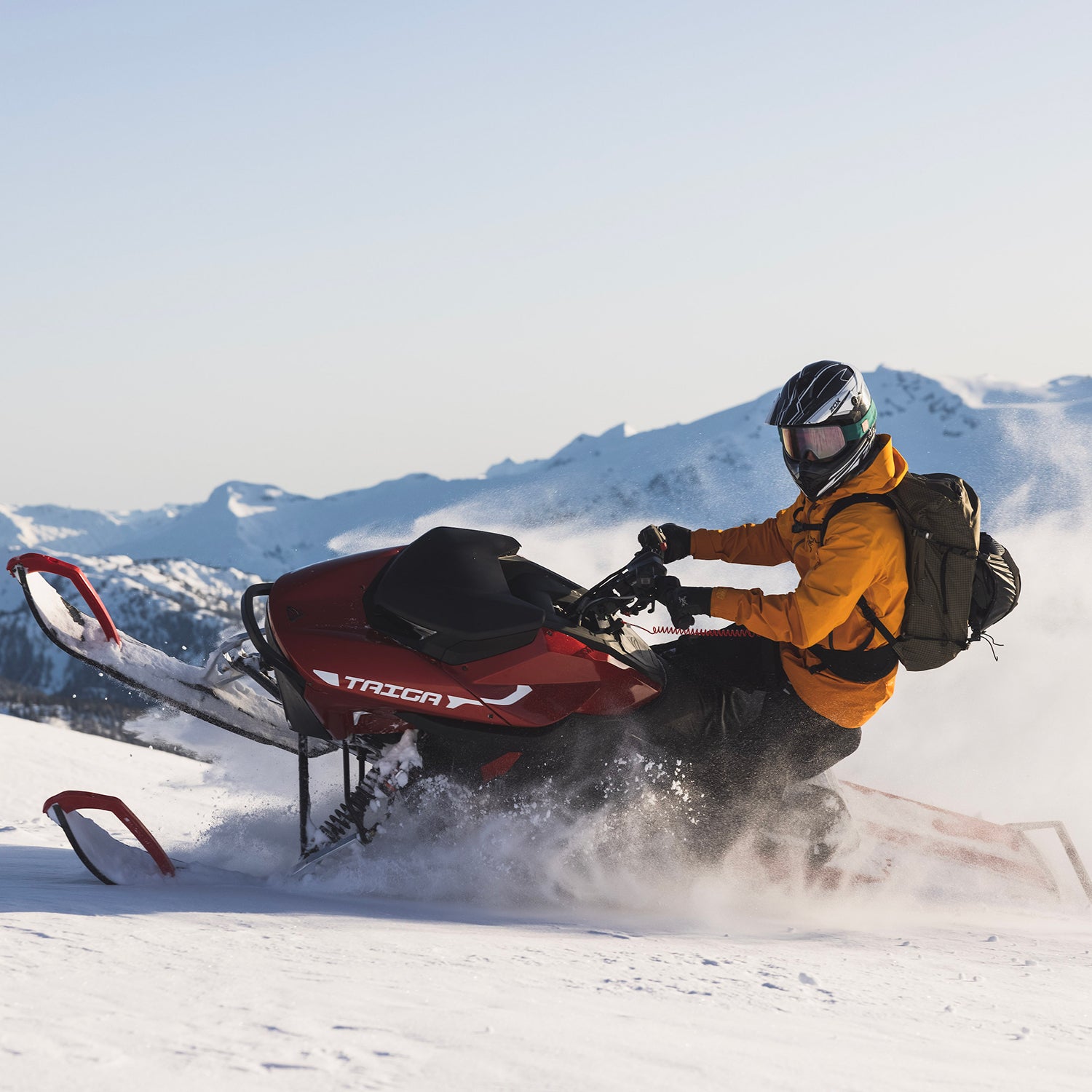It’s a Thursday afternoon in early March 2021, and Gabriel Bernatchez is sitting in his office in Montreal, explaining how he and two college friends are revolutionizing an industry. As a cofounder and the chief technical officer of Taiga Motors, a Canadian startup set to release the first electric snowmobile later this year, Bernatchez has reason for optimism. Three weeks earlier, Taiga that it was merging with a holding company and going public with a $422 million valuation. The 29-year-olds suddenly had $146 million in cash to work with—before they’d completed a single production run.
Bernatchez wore a T-shirt as he downplayed Taiga’s encroachment on the nearly century-old business of manufacturing gasoline-powered snowmobiles. “We’re not exactly competing with combustion,” he says. “I don’t see them as an adversary. I more see them as a different option.”
The estimated market for recreational power sports—snowmobiles, jet skis, and side-by-sides, or ATVs—is $40 billion. The impact of electrification on those segments is enormous from a climate standpoint. And the space is changing fast. The world’s most dominant manufacturer, BRP Inc., which sells $1.8 billion worth of Ski-Doo snowmobiles and Sea-Doo jet skis each year (the two most polluting vehicle segments in this category), in March that it will spend $300 million to develop electric vehicles across all of its product lines over the next five years. BRP followed Minnesota-based Polaris, another of the four major snowmobile brands, which partnered with electric-power-train maker Zero Motorcycles in 2020 to do the same by 2025. In after that announcement, Polaris CEO Scott Wine said, “I never thought I would invest in an electric snowmobile. I thought it was the dumbest idea ever.”
He wasn’t alone in that assessment. Since the first snowmobile was built in 1935 as a means of transportation, its piercing sound and exhaust fumes have been accepted side effects—the price of power, if you will. But while recreational sleds cost a few hundred dollars in the sixties, now they go for $15,000 and accelerate like rocket ships. More than 120,000 sleds are sold each year globally, including 94,000 in North America. Emissions standards that some consider too soft magnify their environmental impact.
Two-stroke snowmobiles, the more powerful of the two main designs (the other, a four-stroke, is slightly more environmentally friendly), are on average allowed to emit 105 times more carbon monoxide than a car. The average two-stroke limits for nitrogen oxides and hydrocarbons are 843 times higher than for a car. Taiga cofounder and CEO Sam Bruneau calls it “startling” that two-strokes are still allowed to be mass produced.
Unlike automobiles, snowmobiles and jet skis aren’t required to include a catalytic converter, which removes pollutants from emissions. (Side-by-sides contain a catalytic converter yet are still more polluting than cars.) Bruneau believes the emissions disparities reflect a misperception that snowmobiles aren’t a big enough market to damage the atmosphere. Part of Taiga’s mission is to improve air quality and reduce the machines’ effects on snowpack in popular riding areas, including around ski resorts. “When you factor in the average between a two-stroke and four-stroke, electrifying one snowmobile is equivalent to taking 40 cars off the road,” Bruneau says in his office, sitting in front of a giant photo of a Taiga tester riding powder in Revelstoke, British Columbia.
While boy-genius-run startups are common in the tech world, motor sports are a different game. Taiga’s founders were outsiders to the tight-knit “sledneck” community, which was both a pro and a con: they were able to see the potential of electric more clearly, but they also could be viewed as intruders. Bernatchez, a climber from Quebec City, went to robot science fairs as a kid and taught himself to code in high school. Hardware specialist Paul Achard grew up in Granby, Quebec, the son of IBM engineers. Bruneau’s dad was a ski instructor at Mont Tremblant, and Bruneau learned to appreciate the quiet of backcountry skiing. The trio met at McGill University, in Montreal, where they teamed up to build 400-pound electric race cars as engineering students. “We just loved chasing performance,” Bruneau says.
They couldn’t run their cars in the winter, so they stuffed their power train in a snowmobile for the , an annual competition for students to create more environmentally friendly designs. They won the zero-emissions category in 2013 and 2014. More importantly, after fielding inquiries from ski resorts and tour companies interested in purchasing electric snowmobiles, they realized no one was doing it commercially. “That was a lightbulb moment for us,” Bruneau says.
The men then won a startup contest at McGill, which delivered their first investor—a local businessman who had mentored them during the contest and gave them a modest check to get off the ground. After graduation in 2015, they turned down job offers from Tesla and Ford, installed 3D printers in their downtown apartment, and founded Taiga, named for the northern boreal forest that stretches across Canada. They built their first prototype from scratch, finishing in early 2017. “Some problems took a year and a half to solve,” says Bernatchez. “Everybody keeps solutions a secret in the industry.”
Unlike an electric car, in which the battery alone can weigh 1,200 pounds, an electric snowmobile has to be lightweight—so a rider can lift it up in deep snow if it gets stuck—and operate in frigid temperatures while maintaining a high power output. Taiga developed : a utility sled (Nomad), a backcountry sled (Ekko), and a crossover (Atlas). They average about 550 pounds, slightly heavier than a two-stroke, but they accelerate faster and deliver 180 horsepower at any altitude, a significant advantage over combustion sleds, which lose 30 percent of their power at 10,000 feet elevation (a two-stroke starts at about 165 horsepower at sea level).
Taiga’s 95-mile range per 30-minute charge won’t be enough for everyone, but most riders cover less than that in a day. Taiga’s sleds also cost $3,000 to $4,000 more than combustion sleds, a premium that might not be worth it to some traditionalists. “But you save a lot on fuel and maintenance, so our goal is basically to have you saving money within two years,” Bruneau says.
BRP, which sells more than half of the world’s snowmobiles, is based 75 miles east of Montreal. It was not lost on Taiga’s founders that one month after they announced they were going public, BRP announced a $300 million investment in the technology Taiga had been developing for six years. “They’re waking up,” Achard says about the bigger manufacturers. “They’ve got some competition breathing down their necks.��I think the truth is, they were waiting for a player like us to come on the scene and put pressure on them.��Because it kind of affects their story, right? If you’re selling two-stroke vehicles and now electric, there’s a disconnect there.”
José Boisjoli, BRP’s president, says he’s not threatened by Taiga. “Competition is good. They force you to stay alert,” he says, “but there’s a big difference between a startup producing some units in a small shop and going worldwide, and us doing it with the infrastructure we have, with 850 engineers and technicians in different countries and a dealer network of 4,500.”
Boisjoli hopes that between 10 and 20 percent of the world’s four million snowmobilers will be riding electric sleds by 2030. And they might not all be on branded machines. Aspen Skiing Company, which consulted with Taiga for years on aspects of design before ending the partnership, started funding its own snowmobile project last winter. Greg Hoffman, a longtime lift mechanic and master electrician, built a prototype with his 16-year-old son, Connor, that the company hopes to replicate and use across its resorts (but not produce commercially). “Greg has a Chevy Bolt, solar on his roof, and in a way he’s sort of the modern man, a sledneck who understands where we’re headed and how cool and fun it is,” says Auden Schendler, Aspen’s vice president of sustainability.
Convincing traditionalists who are set on combustion remains every manufacturer’s biggest challenge. “We got one Facebook comment that said something along the lines of, This’ll be perfect for L.L.Bean-wearing, granola-munching hippies who don’t understand power sports,” Achard says, chuckling. “They all revolve around the same thing—people think they’re going to miss the noise, miss the braap. We’re trying to overcome that core petrol-head reaction of ‘If it’s not gas, I’m not going to like it.’”
Performance can be powerful in that pursuit. Taiga recently tested one of its sleds against a Tesla Model P85D on an asphalt drag track. The snowmobile beat the car seven straight times. Bruneau says his team’s goal is to go from zero to 60 miles per hour faster than the fastest Tesla, the Model S Plaid, which hits the mark in two seconds. (Taiga’s fastest time is around 2.5 seconds.) “Which would be cool, because that Tesla costs 140 grand, and an electric snowmobile costs under 20,” he says.
With Taiga no longer a cash-starved boutique brand relegated to scaling up slowly, what happens next should shape the future of the company as well as the market. Taiga is equally focused on jet skis and side-by-sides, Bruneau says; he and his cofounders only started with snowmobiles because they were the most technologically complex. The company was slated to deliver its first electric jet skis by the end of the year, then its first snowmobiles later this winter (already more than 2,600 people have put down a $500 deposit). Its ATVs should hit the market in 2022, Bruneau says.
The company’s staff quadrupled last year, from 15 employees to 60, and had grown to 170 by November. Over the summer, Taiga moved into a 180,000-square-foot production facility and is building a 340,000-square-foot factory to augment that. By 2025, it plans to produce 60,000 electric vehicles per year, including 15,000 snowmobiles, 17,000 jet skis, and 24,000 side-by-sides—all supported by with 1,100 locations across North America. The snowmobile industry as a whole is growing rapidly; sales during the pandemic jumped 19 percent, the biggest increase in more than two decades.
When Taiga’s founders finalized their nine-figure merger last February, they didn’t spend much time celebrating. “We just gave all the employees a bottle of champagne and asked them to drink responsibly on a teams call one afternoon,” Achard says.��They know they won’t be able to fulfill consumer demand on their own, which is why, despite the competitive landscape, they say they’re happy that big brands are committing to electric, too.
“We really want to solve all these compromising vehicles,” Bruneau says. “We want to enable people to have fun in the outdoors without polluting.”


